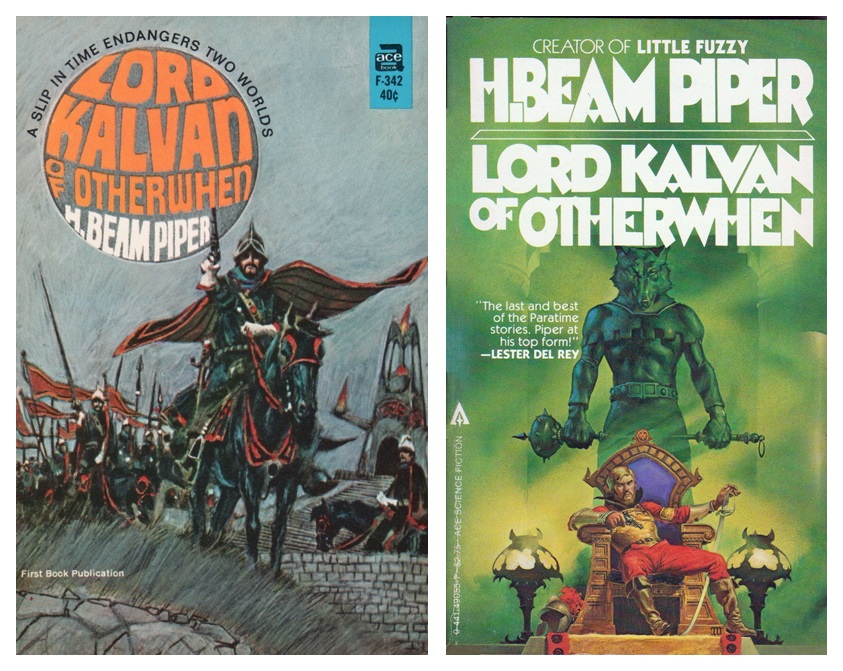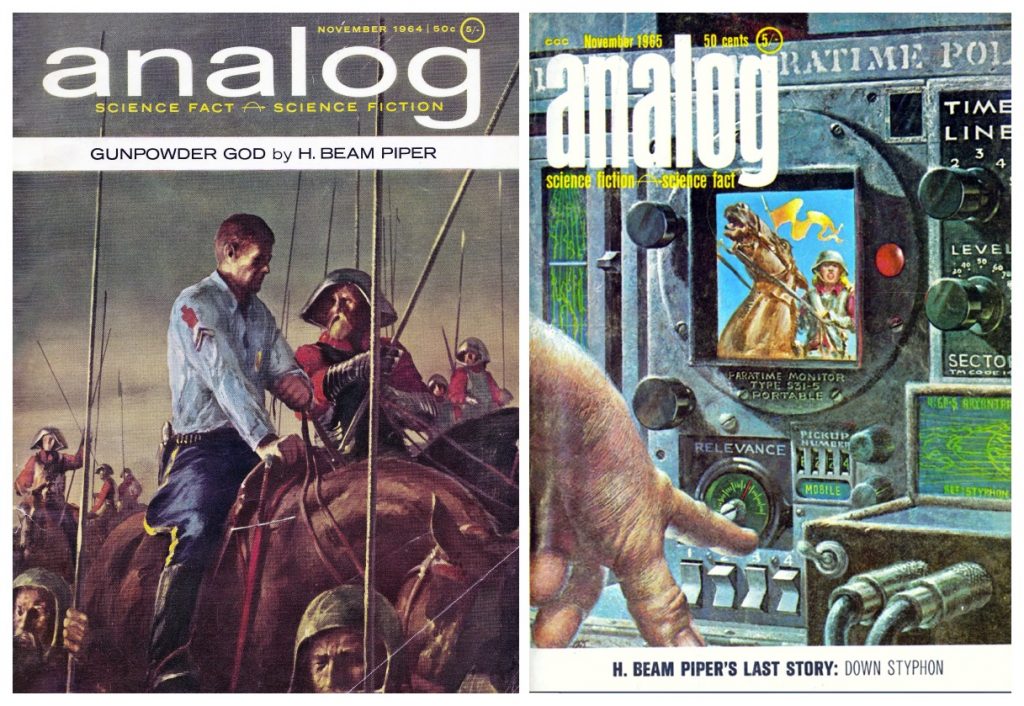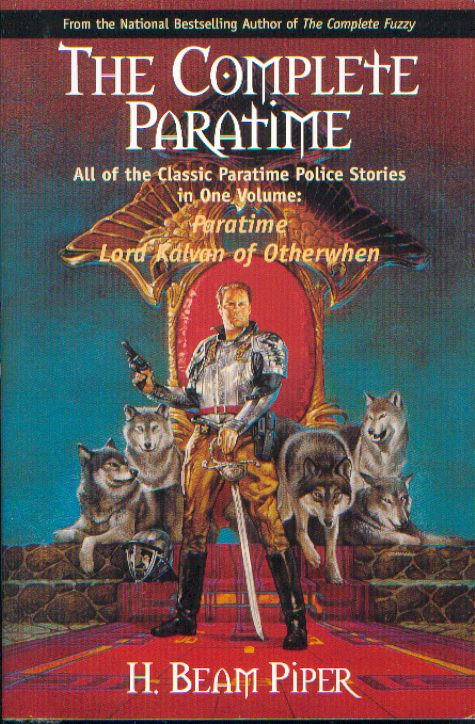Lord Kalvan of Otherwhen: Piper’s Connecticut Yankee Tale

Lord Kalvan of Otherwhen (1984), Ace Science Fiction Books, cover art by Michael Whelan (right)
I think most people are familiar with Mark Twain’s A Connecticut Yankee in King Arthur’s Court (1889). (Certainly, there’s a delightful musical from 1948 featuring Bing Crosby that I loved as a kid.) Twain’s hero is an engineer from Connecticut who receives a blow to the head and is somehow transported in time and space to King Arthur’s England. Although the story is a social satire, it celebrates homespun ingenuity and democratic values, among other things. Although not a satire, Lord Kalvan of Otherwhen (1965) by H. Beam Piper, similarly celebrates good old American ingenuity and values, but takes place on an alternate 20th century timeline instead of the far past. It’s Piper’s last work and part of his Paratime universe.
In this article I’m going give you six (relatively) spoiler-free reasons to read the book, and one reason that has a spoiler, but that I think will only enhance your enjoyment of the work.
In full disclosure, I’ve heard comments from readers complaining that the names in this story are hard to remember. True, they’re vaguely Greek-sounding and not the typical Americanized character names commonly used in stories of this era. But that’s part of the thought-experiment. How would language sound in a very different timeline? We can’t hear their actual voices, but the odd names give us the flavor of the language and how it might have sounded. If we have trouble remembering their names you can bet that the hero did, too.
A Different World
As mentioned, Lord Kalvan is part of the Paratime universe. It was originally published in two parts, the second posthumously to Piper’s death. “Gunpowder God” first appeared in Analog in November 1964. The second part — “Down Styphon” — was published in the November 1965 issue. The novel, Lord Kalvan of Otherwhen (1965), is a compilation of the two which also includes new material expanding on the original stories.
In our reality and timeline, Pennsylvania state trooper, Corporal Calvin Morrison, is part of a group of police about to burst in on a criminal hiding out in an old farmhouse. As he walks forward with pistol drawn, he is accidently caught up in a Ghaldron-Hesthor temporal field. Within the hemisphere of scintillating lights, he sees a man draw a strange weapon and bring it to bear. Morrison draws his own pistol and fires at the paracop, wounding him. He then flings himself aside and rolls out of the temporal field. Morrison finds himself crushed up against a big tree that was not there previously. He stops to think about what’s happened. Where is he? The landscape looks mostly the same, and yet somehow… it’s different. He contemplates this and then goes in search of other people, as the fugitive’s farmhouse has completely vanished.

“Down Styphon” (1965), Analog, cover illustration by Kelly Freas (right)
Back on Home timeline, paracops quickly figure out what’s happened. Our old friend Verkan Vall, Special Assistant to the Chief of the Paratime Police, is there to see the damage.
“A man who can beat a Paracop to the draw won’t sink into obscurity on any time-line,” he says and decides to take charge of the case himself.
Six spoiler-free reasons to read this book
- Piper’s writing style is wonderful — it’s not overly fancy, or whiz bang, but honest and effective. This means that the hero’s thoughts are down-to-earth and very relatable. Plus, it’s my feeling that we are hearing more of Piper’s actual voice in this book, than in the other Paratime tales. Why is that? Because “Lord Kalvan” gives him the chance to play with his knowledge of arms and warfare. More on that in a moment.
- The Paratime world is expanded upon — we learn more about the way an alternate timeline, in fact, how a group of near parallels, are used by the First Level society for study, trade, etc.. We also see some of the complicated dynamics used to manage affairs on multiple timelines. And, we learn more about the history of the First Level’s Home timeline.
- Readers are given a delicious scenario in which to daydream — if you were in Lord Kalvan’s boots, what would we do?
- The war and the weapons — Piper doesn’t write his research, he knows the subject as an expert. The book is filled with period arms and military history. Piper’s passion and enthusiasm for the subject is set out in front of you and it’s infectious. There is a battle scene in the fog that takes place towards the end of the book that is really stunningly good. You feel as if you’re right there, experiencing it with the characters.
- Lord Kalvan’s mental memos — the hero frequently comments to himself about his “to-do” list, including priority. This small detail is delightful and brings us deeper into his mind. We follow his thoughts and wonder…how does he remember it all?
- The book’s closing frame — Verkan Vall and his wife, Hadron Dalla, make cameo appearances in this book. Vall is no desk man and his promotion to Chief of the Paratime Police is rapidly approaching. To stave off the inevitable for a few moments longer, Vall spends as much time as possible on Kalvan’s new timeline. He makes it clear that he has a lot of respect for the man and plans to make that timeline off-limits except for university study (with a series of near parallels as controls). He also plans to make Kalvan’s timeline his own pet project. He tells us, ” We all have hobbies…my hobby farm is going to be the Kalvan Subsector, Fourth Level Aryan-Transpacific….” We can only imagine the fun he’ll have there.
One important spoiler about the Paratime world’s future (and clearly a daydream of Piper’s.)
In the scene mentioned above, Vall and Tortha Karf have a conversation about the Paratime secret. Karf is startled when Vall brings up a comment mentioned earlier by Dalla. He asks — how secure is the paratime secret, really? They discuss the possible results of a Sino-Hindic mystic or an European-American science fiction writer getting accidently picked up by the Ghaldron-Hesthor temporal field and dumped onto a Second or Third level culture which already believes in multidimensional time and alternate probability worlds. They conclude that under these circumstances a parallel development of their own transpational device might be created. Karf decides that this is going to give him nightmares in his retirement. And what about Verkan Vall, the new Chief? He’s now responsible for guarding the Paratime Secret, after all. The book closes with the following sentences referring to Verkan Vall. [He had] “A panther by the tail. And he was holding it.” Suddenly, it seems only a matter of time before someone else intrudes upon the paratimer’s monopoly of parallel reality travel.
H. Beam Piper died, apparently by suicide, in late 1964. “Down Styphon” was his last story (although the bridging material for Lord Kalvan of Otherwhen had already been written, one assumes.) One wonders about Piper’s dreams at the end of his life. Does that last conversation between Verkan Vall and Tortha Karf point to Piper’s personal daydream? I am a proponent of multidimensional realities and infinite timelines and like to imagine that in some timeline or other, Piper was whisked off to an another reality level, before he took his own life.
Lord Kalvan of Otherwhen serves as a fitting conclusion to Piper’s Paratime stories, leaving us, of course, wanting more.
Our previous coverage of Piper’s Paratime stories includes:
Into The Quantum With H. Beam Piper by Sara Light-Waller
H. Beam Piper’s Paratime Tales by John O’Neill
The Omnibus Volumes of H. Beam Piper by John O’Neill
Analog, February 1966: A Retro-review by Rich Horton
SARA LIGHT-WALLER is a writer, illustrator, and avid pulp fan. In 2020, she won the prestigious Cosmos Award for her illustrated space opera story—“Battle at Neptune.” She’s published two illustrated new pulp books—Landscape of Darkness and Anchor: A Strange Tale of Time and is a regular contributor to several pulp blogs. Catch up with her at Lucina Press.

[…] (3) NOT THROWIN’ AWAY MY SHOT. Black Gate presents Sara Light-Waller’s commentary: “Lord Kalvan of Otherwhen: Piper’s Connecticut Yankee Tale”. […]
In regard to your first point, Ms. Light-Waller, I believe I once heard Jerry Pournelle say pretty much the same thing. Calvin Morrison’s interest in firearms and military history mirrored Piper’s areas of expertise and his voice is clearer in these two stories.
I’m glad he agreed. 🙂 This was certainly an opportunity for Piper to have some fun with what he knew and loved. If you’ve ever read his novel, “Murder in the Gun Room” (1953) you’ll note it has much the same feeling, although it’s a mystery not a fantasy as is “Lord Kalvan.” Thanks for your comment, John.
As far as I recall I have read all his work, both in the magazines and paperbacks.
I remember reading Gunpowder God. My father subscribed to analog in the 60’s and there was a stack of them in the house in the original Tabloid style . I hung on to them for as long as I could but shortly after I left home for the Army my mom tossed them out along with my collection of GI Joe’s.
[…] There’s no doubt that H. Beam Piper’s “Paratime” stories are some of my favorites. I like stories about time and multi-dimensional travel and his are some of the best. My second article for the online magazine — “Black Gate” is now live. you can read, “Lord Kalvan of Otherwhen: Piper’s Connecticut Yankee Tale” right here. […]